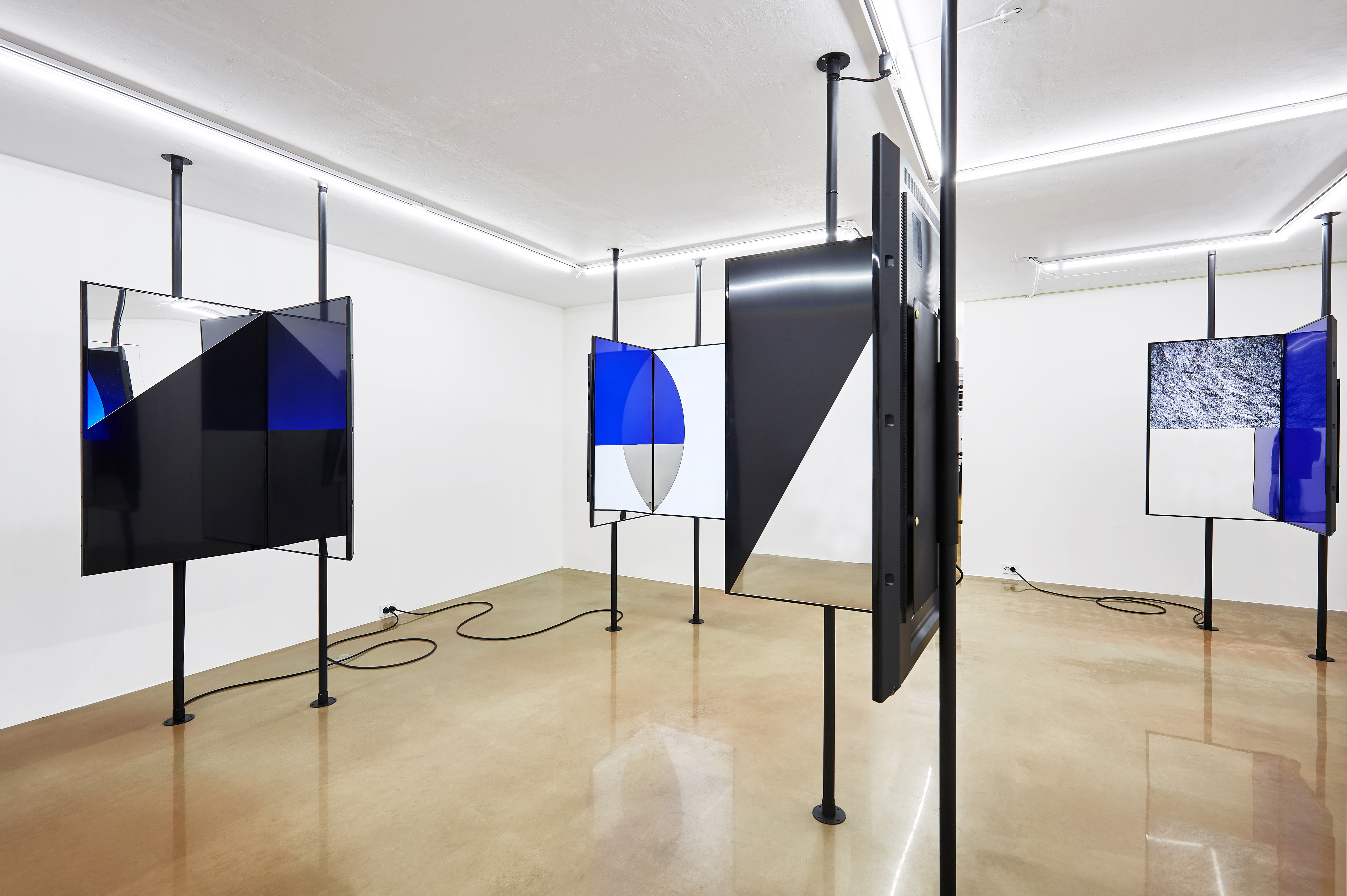Flat Matters,
mixed media, dimension variable,
2018
『납작한 세계』는 개인의 영역으로 침투한 미디어가 세계를 평평한 이미지로 전송하는 현상에 대한 반추에서 시작된다. 실제의 세계는 폭과 높이, 깊이가 제거된 이미지로 조작되고 유통되며 디지털 세계에 익숙한 수용자의 언어와 사고 습관을 통해 새로운 유형의 세계로 소비되고 발화된다. 육체는 실제의 세계에 있지만 사고는 보이지 않는 세계에 있는 것이다. 미디어의 평평한 스크린은 세계를 납작한 이미지로 유통하며 이를 가속화시키는데 일조한다. 나는 인간의 발명품인 미디어가 조용히 인간의 생각과 행동에 영향을 미치는 이 유기적 관계에 자문하며 디지털 스크린의 형식적 특징을 조형 언어로 치환하고 미디어가 반영하는 이미지들이 납작한 물질에 불과한 것을 드러내고자 한다.
이전 작업들의 경우 인간을 둘러싼 도구들, 주로 언어와 신체 그리고 미디어에 대한 사유와 개념적 연계성을 복합 매체(mixed media)를 이용해 압축적이고 은유적인 방식을 이용해 드러내왔다. 그리고 그 기저에는 근본적으로 불완전한 세계관과 개인적 사유가 함께 결합되어 있었다. 신작 「납작한 세계(Flat Matters)」는 미디어로 전파되는 허구적 이미지와 실제의 간극, 오류로써의 세계를 함축적 이미지로 소거하여 다시 스크린의 물성을 빌려 나타내는 작업이다. 세계의 상품화와 의식의 점령을 가속시키는 스크린 매체를 기념비적 형태로 치환하여 미디어에 대한 사유를 담아내는 것으로 볼 수 있다.
다른 대상을 ‘투영'하지만 ‘실제'가 아닌 것을 비추며 ‘평평'하게 존재하는 스크린과 거울은 서로를 매개하며 평면 너머의 공간을 생성하지만 실상 반사되는 허상의 이미지다. 완벽하게 다듬어지고 포장되어 전달되는 세계의 이미지 속에서 우리의 생각과 행동은 오롯이 나의 것인지 확인할 방법이 없고, 허상을 좇기에 숨가쁘다. 디지털 사회가 주장하는 미디어의 ‘공유'라는 개념은 실제와 가상의 반대개념을 뜻하는 불교에서의 ‘공유(空有)'*와 같다는 사실도 아이러니하다. 실제와 비실제, 평면과 이면, 허상과 현실 사이에서 리셋(Reset)하면 처음으로 돌아갈 수 있을 것 같지만 이것도 다시 현실의 이야기는 아니다. 네트워크 상에서 발견된 비물질 파일 표본들과 오류 가득한 화면들은 어쩌면 허구 가득한 디지털 사회에 걸맞는 모뉴먼트가 아닐지 자문해본다.
*공(空)과 유(有), 평등과 차별, 실체와 가상(假象)처럼 논리상 반대가 되는 두 개의 개념을 이르는 말.
Flat Matters begins from rumination on the phenomenon of flat images of the world being transmitted by media that have infiltrated the personal domain. The real world is manipulated and distributed as images stripped of height, depth, and breadth, consumed and articulated as a new form of “world” through the language and thinking habits of consumers accustomed to the digital environment. Our bodies exist in the real world, but our thoughts lie in some unseen world. The flat screens of media help to accelerate this, circulating the world in flattened image form. In posing questions to myself about this organic relationship -- whereby the human invention of media quietly influences human thought and behavior -- I am attempting to transpose the formal characteristics of the digital screen into an artistic language, showing the images reflected in media to be nothing more than flat matter.
In my previous work, I adopted a compressed, metaphorical approach, using mixed media chiefly to show ideas about the tools that surround people -- chiefly language, the body, and media -- and their conceptual linkage. Underlying that was a combination of a fundamentally incomplete world view and personal contemplation. The new series Flat Matters (2018) once again uses abstract images to erase the gap between the real and the false images propagated by media -- the world of error -- and present them anew using the materiality of the screen. It can be seen as a matter of capturing ideas about media by transposing into monolithic shapes the screen media that are accelerating the world’s commodification and the occupation of our consciousness.
Existing as “flat” objects that show reflections of their objects yet present things that are not real, the screens and mirrors are illusory images: though they form spaces beyond two dimensions as they mediate one another, they are in truth reflected. Within the images of the world, transmitted to us in perfectly processed and packaged form, we breathlessly chase after illusion, having no way of seeing whether our thoughts and behaviors are completely ours. In Korean, the word for “sharing” (gongyu) as used in the concept of “media sharing” advocated by the digital society is, ironically, a homonym of the word used in Buddhism to refer to the opposing concepts of the real and false.* Between real and unreal, the plane and its underside, the illusory and the real, it may appear possible to “reset” and return to the beginning -- but that is not how the reality operates. The immaterial file samples discovered on networks and the error-filled screens may represent apt monuments for a digital society replete with fiction.
*Consisting of the syllables gong (nothingness) and yu (being), this refers to two logically opposed concepts such as being and nonbeing, equality and discrimination, the real and the imaginary.







